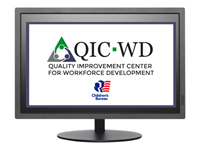Child Welfare Quality Improvement Center for Workforce Development (QIC-WD)
Date of this Version
2-2022
Document Type
Article
Abstract
What is Secondary Traumatic Stress (STS) and why was an intervention designed to address it?
The Quality Improvement Center for Workforce Development (QIC-WD), in partnership with the Nebraska Department of Health and Human Services Division of Children and Family Services (DCFS), conducted several surveys with a sample (40%) of child welfare workers and supervisors in December 2017, as a part of the needs assessment process. One of those surveys assessed the presence of secondary traumatic stress (STS) symptoms. Of the child welfare workers and supervisors that responded, 53% indicated that they had recently experienced elevated levels of STS symptoms. This was higher than other QIC-WD sites that completed the same survey. Additionally, a study conducted in another jurisdiction, found that 37% of child welfare workers reported at least moderate symptoms of STS (Baugerud, Vangbaek and Melinder, 2018). Together, these findings indicated Nebraska’s rate of STS was high relative to other child welfare workers.
STS refers to the stress individuals experience after secondary exposure to trauma and can mimic the symptoms of Post-Traumatic Stress Disorder (Bride, 2007) such as nightmares, avoidance, sleep disruption, and irritability. Child welfare staff are particularly susceptible to STS because of the vulnerable nature of the families they work with, the unpredictable nature of their jobs, and their general lack of physical and psychological protection (ACS-NYU Children’s Trauma Institute, 2011). Considering STS as an occupational hazard for those working in child welfare, it’s important for organizations to understand how they can proactively support frontline staff. This not only has the possibility of increasing employees’ well-being, but may also mitigate the link between STS and retention (Barbee et al., 2018).
How was Nebraska’s intervention to address work-related STS developed?
In an effort to build staff resiliency and enhance retention, DCFS worked with the QIC-WD to develop CFS Strong–Building a Resilient Workforce (known as CFS Strong). Using the Chadwick Trauma-Informed Systems Dissemination and Implementation Project guidelines, various areas for intervention were considered. Ultimately, adjustments to the hiring phase were not feasible and foundational STS training was already in place for new workers. Therefore, CFS Strong focused on addressing work-related traumatic stress through ongoing skills development and targeted support after specific traumatic events for existing frontline staff (for more information, see Intervention Overview).
To support long-term resiliency, DCFS implemented an adaptation of Resilience Alliance (RA), which included peer-led Peer Support Groups (PSG) post-RA, and resiliency reminders sent to participants throughout RA and PSG. RA was developed by the New York City Administration of Children’s Services-New York University Children’s Trauma Institute. According to the RA manual and this practice brief, RA can lead to positive outcomes for new and veteran staff, including increased resilience and perceived coworker and supervisor support, as well as decreased negative emotions and perceptions of themselves and their work. Furthermore, the RA manual cited a 2007 pilot, linking the implementation of RA to reduced attrition (25% vs. 45%). However, the methods for these studies were unclear, and despite the strong relevance to the child welfare field, no peer-reviewed research studies have been published on the RA program.
To support staff in processing their stress reactions after a traumatic event, DCFS piloted Restoring Resiliency Response ©(RRR) debriefings, created by the New York Society for the Prevention of Cruelty to Children (NYSPCC). The RRR model was informed by research and focus groups with child protection workers. Internal evaluations have shown positive reactions from frontline staff (e.g., staff indicated the sessions were helpful, they felt safe, they were likely to encourage others to attend an RRR session). The QIC-WD picked this debriefing model because of its similarities to RA, application to the child welfare workforce, and participant acceptance. Most importantly, RRR sessions are not investigatory, but rather focus on the current stress reactions. Other debriefing models were considered, but some required staff to recount the traumatic event and had even been shown to cause further harm.
What research gap is the QIC-WD addressing?
The QIC-WD and DCFS co-created CFS Strong to build resiliency and support frontline child welfare workers and supervisors. The site-level evaluation for Nebraska will contribute to an understanding of effective solutions for addressing STS within the child welfare workforce, see the Evaluation Overview for more information on the research questions and evaluation design. Specifically, this evaluation will provide a much-needed rigorous, randomized control trial of RA to the child welfare field. Such evaluations are rare due to the complexity of conducting randomized studies in functioning child welfare agencies. The evaluation will also provide information to guide implementation of the RRR model (1) as adapted to a more rural context and (2) adapted for a hybrid (remote and office-based) agency context. These differ substantially from the urban, in-person context where RRR was first evaluated.
Included in
Industrial and Organizational Psychology Commons, Performance Management Commons, Public Policy Commons, Social Welfare Commons, Social Work Commons, Training and Development Commons


